Piła 09-08-2024
Geographical coordinates: 53.142N 16.741E. Elevation 59 m (194 ft).
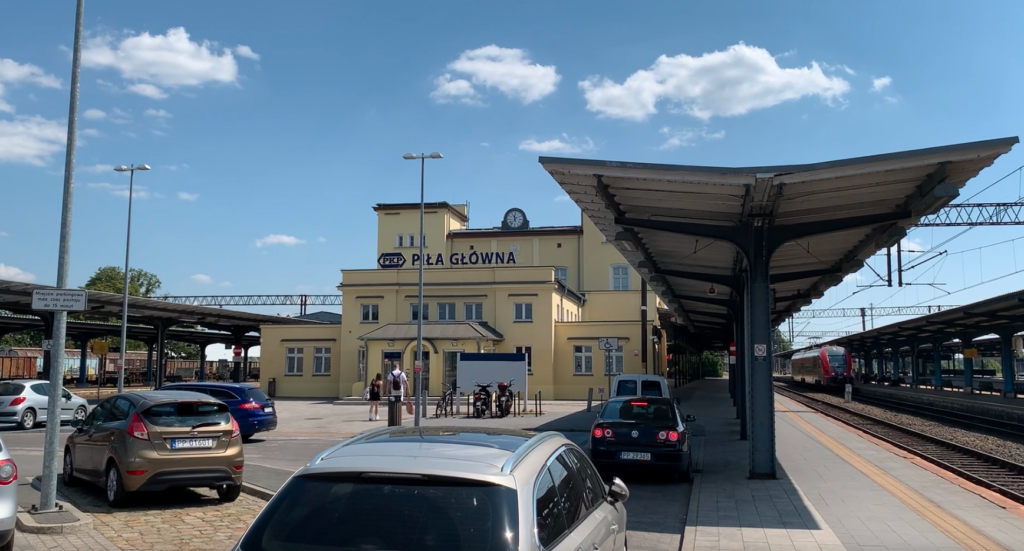
City of Piła.
The city of Piła is located in the Greater Poland Voivodeship and is the seat of the County. In the period 1975-1998, it was the capital of Piła Province. The city is situated on the river Gwda, which is the right tributary of the Noteć. It is only 10 km from the centre of Piła to the Noteć River. The main driver of the city’s development is its location between Bydgoszcz, Poznan and Gorzow Wielkopolski. The city is also an important regional academic centre with branches and offshoots of state and private universities from Poznan, Bydgoszcz and Szczecin.
Piła is an important city in Poland. It ranks 51st in terms of population and 27th in terms of area. According to data from 30 June 2010, the city had 74,557 inhabitants. The area is 102.68 square kilometres. The population density is 726 persons per square km. The altitude in relation to the sea is 50-134 m above sea level. PP vehicle registration plates.
Development of railways in the Piła area.

The real development of Pila came in the middle of the 19th century, when the development of the railway began. The construction of the railway from Berlin to Königsberg was initiated by the Prussian state, and personally by King Frederick William IV of Prussia, who presented plans for the railway in 1842. The investment was state-owned and not by private companies. In 1848, the Berlin-Szczecin railway route was opened and the construction of the Szczecin-Poznan route began. When designing railway routes, ease of track construction was taken into account rather than the shortest route. The existing steam locomotives at the time were weak and struggled to climb hills, so the rail route had to be flattened.
On 27 July 1851, a railway line was opened from Bydgoszcz via Piła to Krzyż Wielkopolski and on to Szczecin and Berlin. The railway route from Krzyż Wielkopolski to Piła was laid along the Noteć river, and further from Piła to Bydgoszcz also along the Noteć river. From Piła to Krzyż Wielkopolski is 65 km and the train covers this route in 50 minutes. From Piła to Bydgoszcz it is 90 km and the train covers the route in 1 hour and 15 minutes.
In the following years, connections from Piła to Poznań, Kołobrzeg and Wałcz were established. In this way, Piła became an important railway junction. A rolling stock repair facility was built here. Piła Główna is an island-type station, much like Krzyż Wielkopolski or Poznań Główny. After the Great World War, the Treaty of Versailles left Piła on the Germanic side. Railway traffic in the direction of Poznań and Bydgoszcz was halted. There was no traffic to Poznań until the outbreak of the Second World War.
The station is located in the southern part of the centre of Piła, at 1 Zygmunta Starego St. The passenger station has six platforms. The station was electrified in the period 1989-1990, and all semaphores were replaced with luminous ones. A 230 m long viaduct was built over the tracks in 1975, connecting the northern and southern parts of the city. Between 2014 and 2018, the station was refurbished for the last time.
The railway junction in Piła is one of the most important in Poland. There were five railway stations in Piła; Piła Główna, Piła Kalina, Piła Leszków, Piła Podlasie, Customs Station. Currently, the following routes run through Piła: No. 18 Kutno – Piła Główna, No. 203 Tczew – Küstrin Kietz (non-electrified), No. 354 Poznań – Piła Główna, No. 374 Mirosław Ujski – Piła Główna (non-electrified), No. 405 Piła Główna – Ustka, No. 999 Piła Główna – Piła Północ. Piła also has railway line No. 403 – 126 km long, connecting the branch station Piła Północ with Ulikowo station (non-electrified).
Piła is a railway junction where seven railway directions meet. Currently (2024) there is one railway station Piła Główna and four passenger stops; Piła Fabryczna on LK No. 18, Piła Podlasie on LK No. 203 and Piła Kalina and Piła Leszków on LK No. 354. The Piła Leszków stop has been closed since 2008. Piła Główna station includes a goods station, which is located west of the passenger station and extends along LK No. 203. It included a shunting hill, no longer in use. Part of the track has been demolished.
Piła Główna station is located in the Śródmieście / Staszyce district, in the southern part of the centre of Piła, at 1 Zygmunta Starego St. The station was put into operation on 27 July 1851. The station had the Germanic name Schneidemühl during the period of partitions (1851-1943). During the Second World War the name was changed to (1944) Schneidemühl Hauptbahnhof and then to (also in 1944) Schneidemühl Personenbahnhof. After the incorporation of Piła into Poland, in 1945, the station was named Piła, and in 1968, the name was changed to Piła Główna.
After the Great World War, Piła remained in Germanic hands, although the majority of the inhabitants were of Polish nationality. It was only 6 km to the border with the Republic of Poland. Due to the aggressive actions of the Germanic people, the section of the Piła – Poznań railway line between Piła Kalina and Dziembówko was dismantled. The tracks were laid again by the Germanics during the Second World War. In the inter-war period, the Germanics in Piła established a customs station for international freight traffic. This was mainly for goods trains that were diverted from Germanicus towards Bydgoszcz. The customs station was located on the eastern side of the river Gwda. After the Second World War, when Piła became part of Poland, the station was demolished and the buildings were adapted into flats for railway families. The existence of the customs station is recalled by the street name Customs Station and the large station plaza. There is now a Piła Fabryczna passenger stop next to the former station.
In the period 1920-1939, train traffic at Piła station, was specific. Most passenger and goods trains were transit trains. In the eastern direction, trains went to Bydgoszcz or Chojnice. In the westbound direction, trains mainly went to Berlin. Passengers who travelled to Bydgoszcz were checked in at the railway station and goods trains at the Customs Station. The trains between Piła and Bydgoszcz were made up of Polish rolling stock; locomotives and wagons. Freight wagons were run in a shuttle system.
In 1975, a 230-metre-long viaduct was built over the tracks of Piła Główna station, along Piastów Avenue, which connects the northern and southern parts of the city. From the viaduct there is an exit to the station square. Access to the station square for cars is from Zygmunta Starego Street via a railway-road junction. You have to cross 5 tracks. The crossing is protected by barriers. The main entrance for travellers is from the square on 14 February Street. There is a TAXI stand and public transport stops here. This entrance directs travellers into the tunnel.
The electrification of Piła Główna station took place between 1989 and 1990, but was not completely completed due to the non-electrified LK No. 203, LK No. 403 Ulikowo and LK No. 374 Ujście. All semaphores at the station have been replaced with light semaphores. There are currently (2024) no plans to electrify further lines.
There are 6 platforms and 10 platform edges at Piła Główna station. Passengers access to the station, platforms and town centre is provided by tunnels. The platforms are numbered from the station towards the south; 1, 2, 3, 4 and platforms 5, 6 are on the north side of the station. Platform 1 is a single-edge platform with a length of 260m. Island platform 2 is 420 m long. The platform can technically be significantly extended. Island platform 3 is 380 m long. Island platform 4 is 300 m long. Platform 5 is a single-edge platform with a length of 330 m. Platform 6 is an island platform with a length of 330 m. Each platform has a canopy and tunnel access. The shortest canopy is on Platform 4 and is only 45 m long. The canopies over Platforms 1 and 5 were there from the very beginning of the station. There are three passenger tunnels at the station. One tunnel leads about the entrance from the city by the TAXI stand, into the interior of the station. The other tunnels lead to the platforms; one to Platforms 1, 2, 3, 4 and the other to Platforms 5 and 6.
In the eastern part of the station there is a technical area with locomotive depot buildings. This area is bounded by the River Gwda. The main buildings are the steam locomotive depot and the second steam locomotive depot, the so-called ‘Roundhouse’. At present (2024), a company called ‘Interlok’, which deals with repairs of historic steam locomotives, operates on the site. The steam locomotive depot, or rather a complex of buildings for steam locomotive service, was built between 1870 and 1874. Its construction was necessitated by the increasing railway traffic in this part of Wielkopolska. The ‘Okrąglak’ steam locomotive depot was designed as a modern facility and became a model for other such facilities in Europe.
In the western part of the station is the goods station and the former facilities of ZNTK (Railway Rolling Stock Repair Works), which were closed in 1995. The workshops were opened on 1 October 1907. On 25 May 1994, the marshalling yard was closed.
On 19 May 1988, a military transport train crash took place in the area of Piła Główna station, killing 10 soldiers and injuring 28 people.
In the period 2000-2012, there was no passenger traffic through Wałcz and Kalisz Pomorski stations. This was the period of the greatest reductions in passenger services after the rule of the Freemasons, Communists and Volksdeutsche. Fortunately, these stations have regained passenger connections. This makes it possible to travel from Piła to Stargard and Szczecin.
Rail traffic at Piła Główna station is controlled from five traffic control stations: PłA, Pł1, Pł3, Pł5 and PPn (podg Piła Północ on LK Nr 405). There are active railway sidings; To the former Piła branch of GCB Centrostal Bydgoszcz. To the Philips Lighting Polska light bulb factory. To the NAFTA Oil and Gas Exploration plant on Powstańców Wlkp. Avenue. There were also sidings; To the Przedsiębiorstwo Robót Drogowych i Mostowych. To Zakłady Przemysłu Ziemniaczanego. To Prefabet Works. To the Piła airport. To the military unit. To warehouses at Zygmunta Starego and Towarowa Streets. To the coal depot. To the Higher Officers’ Car School. To the Potato Industry Plant. To the printing works. To the spirit bottling plant. To the municipal power station. To the city gasworks. To the Chemitex chemical works. To the retting plant.
In 2021, passenger traffic amounted to 1,170,000 passengers during the year.
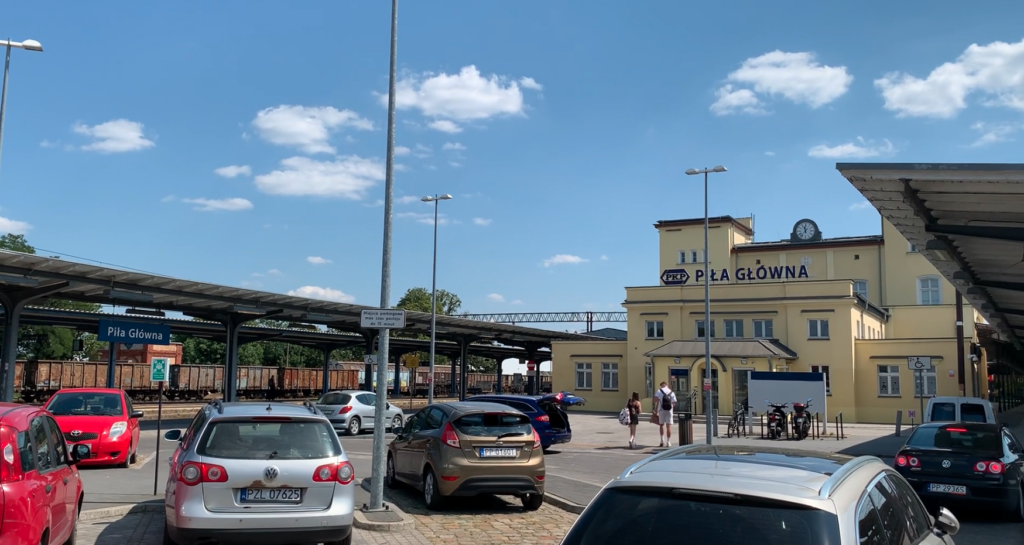
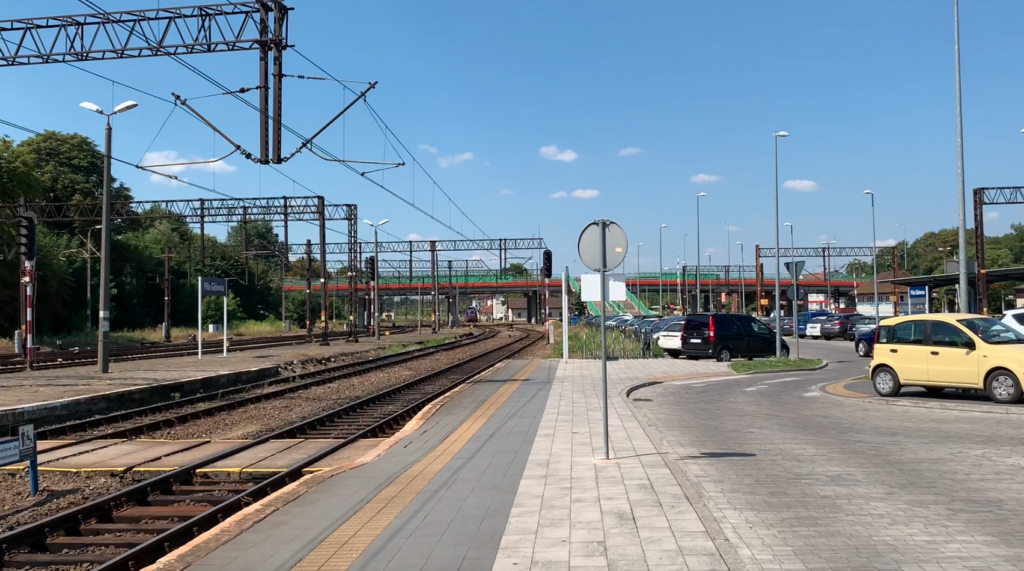
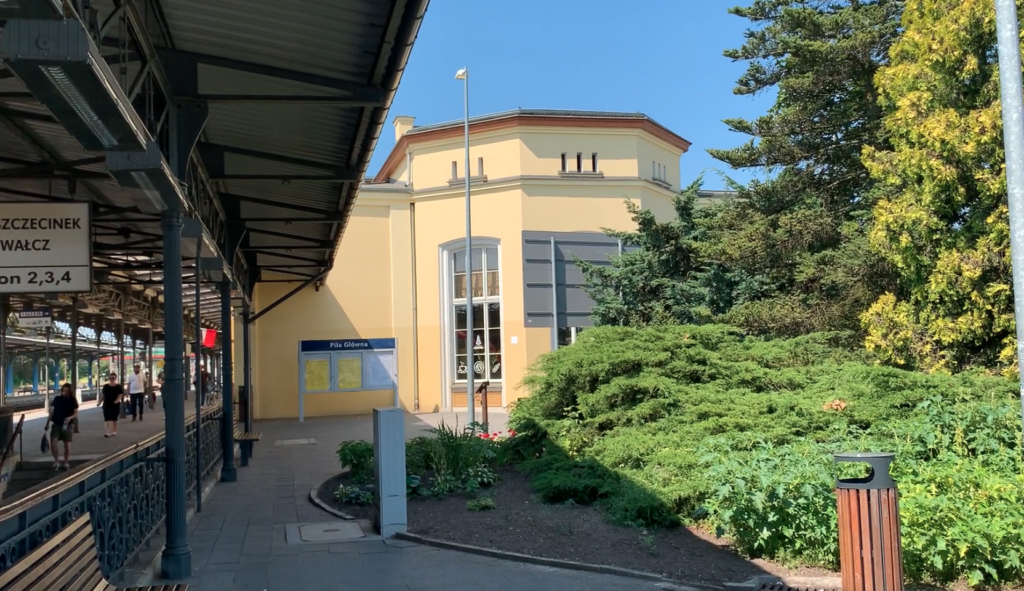
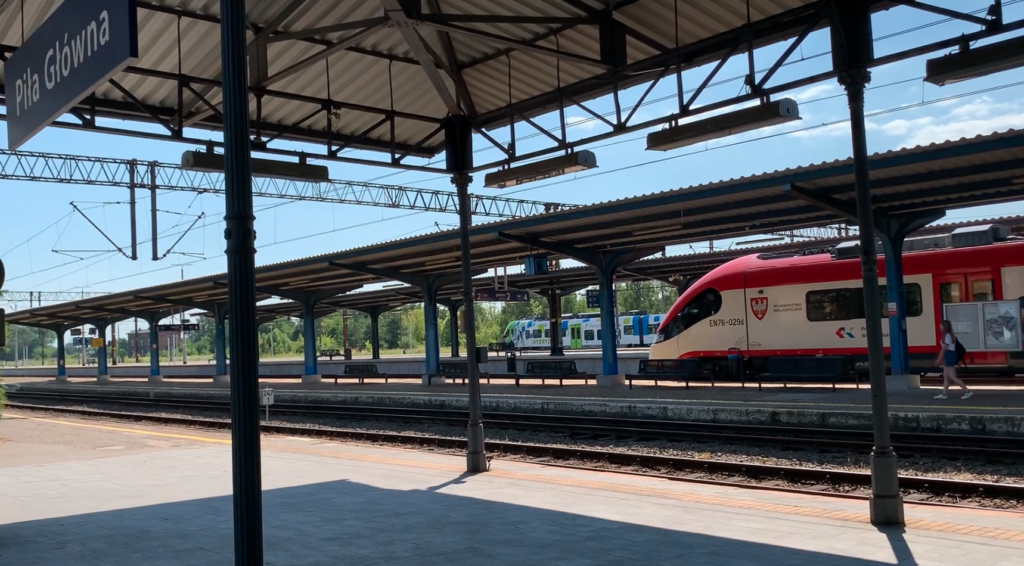

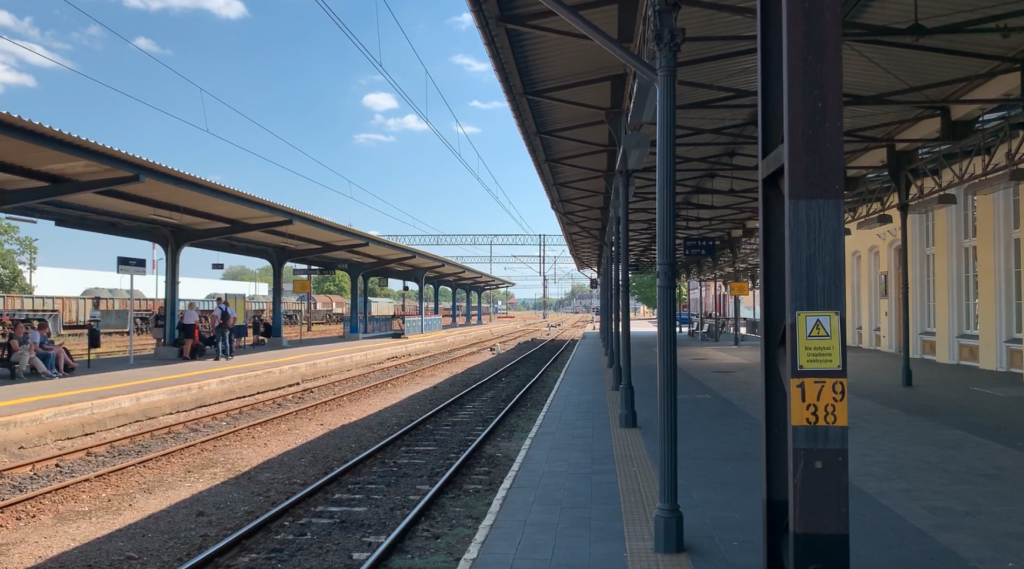
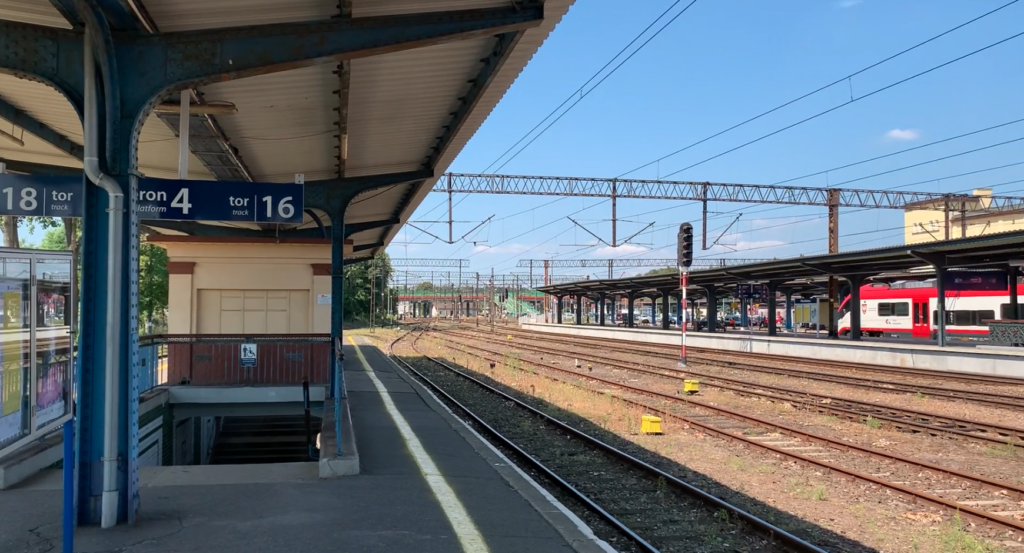
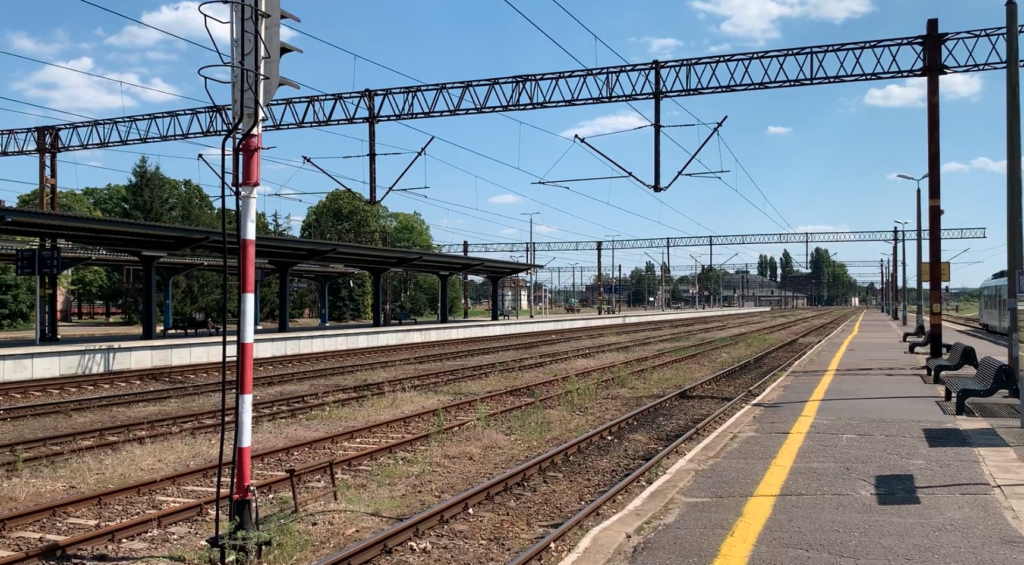
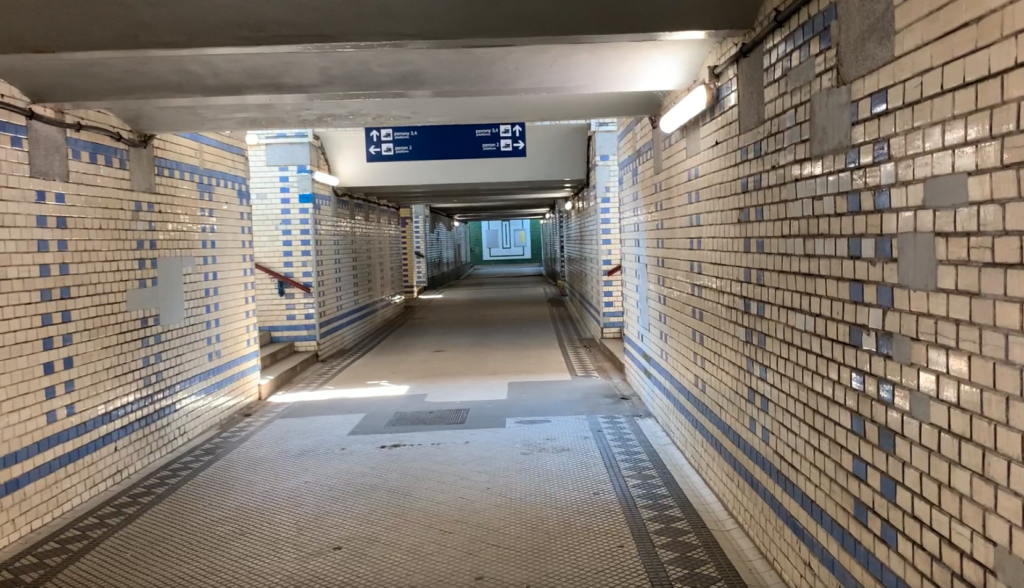
Piła Główna station.
The station was built between 1853 and 1876 and has been modernised several times in its history. There has always been a clock on the front of the building. The building was built on an elongated rectangular plan. The station is a brick building. The walls were originally faced with brick and are now plastered on both sides. The roof was covered with tar paper. The interior was originally covered with wooden ceilings, which were replaced with reinforced concrete ceilings during the post-war reconstruction. The corners are topped with turrets to suggest a castle. The building is two-storey with an additional storey above ground. In the early years of the station, a single-storey representative entrance was added with five large windows in which doors were fitted. The roof of this extension had a representative terrace.
The interior of the station was fitted out with a ticket and luggage hall, three waiting rooms (according to ticket class), a restaurant, representative rooms for the king and his family, service rooms and flats for the stationmaster and restaurateur. Around 1892, a footbridge over the tracks for pedestrians was built in the eastern part of the station to connect the town with the station. The footbridge was short-lived as it was replaced by passenger tunnels. The entire tunnels were completed around 1910. The tunnels are a unique construction in Europe. They have retained their original vaults and walls lined with ceramic fleece. The canopies of Platforms 1, 5, which are adjacent to the station are also unique. They are mainly made of cast iron construction. The railings at the entrances to the tunnels are similarly made.
After 1910, the entrance to the station building was rebuilt. A small superstructure was made on the terrace, two entrances consisting of double doors were made and smaller windows were put in all over the frontage. The interior was adapted to meet the needs of railway services. The corner turrets were given flat roofs and ornaments were removed. In 1911, the station received an electricity system and a little later a sewage system. The water system was there from the beginning.
At the rear of the building a garden with flower clubs and trees has been laid out. The rear elevation of the building has a projecting broken wall, with three huge windows, and the interior housed the royal flats and later a restaurant.
On the eastern side of the station, further buildings were constructed for railway services. There was a post office, a telegraph office, a telephone exchange, a forwarding office, a dormitory with a canteen, a bathhouse, and toilets.
In the 1960s, the station was renovated again. The woodwork was replaced and the west entrance was rebuilt again. A porch with three windows and two side entrances was created. The façade was rendered in cream colour with burgundy elements. A neon sign with the inscription Piła Główny PKP was placed on the façade. This neon sign in the 80s of the 20th century, was replaced by the simpler inscription Piła Główna PKP on a white background. In the 90s of the 20th century, a white crowned eagle and the date 14 February 1945 were placed on the facade of the building. The date represents the takeover of the station by the PKP.
The station at Piła Główna station is an island-type station and tracks run on both sides. The station was entered on the list of monuments on 7 July 2010, under number 796/Wlkp/A. Together with the station, the ‘Okrąglak’ steam locomotive depot was also listed.
The last renovation of the station was carried out in the period 2014-2015. The renovation included the roof, façade, interior, window and door frames, electrical system, water and sewage system. The façade was changed to a bright yellow colour. The station has been adapted for the disabled. The station has ticket offices, waiting rooms, toilets, luggage lockers, a station café, small retail outlets, a Municipal Police post, a SOK post. Small architecture has been changed; benches, display cases, waste bins. The square in front of the station with 70 parking spaces was renovated. The cost of the renovation amounted to PLN 18.5 million. The station was reopened on 26 October 2015.
Königliche Lokomitivwerkstatt, then ZNTK in Piła.
Steam locomotive repairs began in Pila as early as 1906. This was due to the large increase in the number of railway routes and the increase in rolling stock. By this time, construction was already underway for the new facilities for the workshop, which were ceremonially opened on 1 October 1907. It was supposed to be one of the largest workshops in Prussia, but it never was. In the first few years, around 5 million marks were spent on the investment. The plans included the construction of large social and leisure facilities for the workers. Several blocks of flats were built in the current streets: Świętojańska and Reymonta.
A boiler house, forge and mechanical workshop were built. A foundry was not built, which significantly limited the repair possibilities. The forge was also not equipped with heavy steam hammers. For this reason, the workshops had to cooperate with other larger ones, especially the Stargard Workshop. Locomotives were used to drive the machines. There were machine tools, cranes and overhead cranes. The expansion of the workshops continued until 1910. In 1913, there were about 1,200 workers in the workshops. At the same time, up to 150 people worked at the railway station.
In 1914, the Germanics started the Great World War. As a result of this war, the Republic of Poland regained its independence. The town of Piła found itself 6 km from the Polish border. As a result, the workshop was losing its importance. The accumulated production potential was not fully utilised. Between 1920 and 1939, around 700 workers were made redundant, most of whom went to work in Stargard, and Poles moved to Poznan or Bydgoszcz. The biggest problem was the lack of an iron and bronze foundry. The small boiler house only overhauled boilers for small steam locomotives, mainly tenders. Large boilers were overhauled in Stargard. Acetylene gas and wood gas generators (generator gas, chadnica) were used to a small extent.
During the Second World War, the plant received large repair jobs, for the Germanic war machine. Employment rose to nearly 2,000 workers, most of whom were forced labourers who lived in wooden or metal barracks near the workshops.
In 1945, the fighting for Pila, which was in the Pomeranian Wall system, lasted three weeks. The entire railway station and workshops were surrounded by transzeji and fire positions. Piła was also defended by a Germanic armoured train. The seizure of the town of Piła by the Soviets took place on 14 February 1945. In Piła, the railway infrastructure was 80% destroyed. What was not destroyed by warfare was taken away by the Soviets to Moscow.
On 18 February 1945, the Soviet authorities allowed the PKP to take over the station. On 24 February 1945, the Ministry of Communications issued a decision to proceed with the rebuilding and launch of the Steam Locomotive Repair Workshops in Piła. The workshops undertook rolling stock repairs and were part of the station management. On 19 March 1945, the Polish State Railways officially took over the plant and named it the PKP Main First Class Workshop in Piła. At that time, the plant had about 100 employees. On 18 July 1946, the 100th steam locomotive was repaired.
In August 1950, the workshop was renamed Mechanical Workshop No. 14 in Piła, and from January 1951, the plant was renamed PKP Steam Locomotive Repair Plant No. 14 in Piła. In January 1952, the workshops were renamed Zakłady Naprawcze Taboru Kolejowego w Pile. The rebuilding and expansion of the workshops continued all the time. The boiler house was extended. Welfare facilities were rebuilt and a canteen was opened. An iron and bronze foundry was built. The name of ZNTK in Piła was changed in 1982 and in 1991.
From 1976, ZNTK started to overhaul the diesel traction. In 1979, around 169 diesel locomotives were repaired. Social and economic changes in 1989 led to the introduction of the market economy and further transformations. ZNTK in Piła was transformed into a sole shareholder company of the state treasury, which soon went bankrupt. In 1995, the company went bankrupt and was liquidated. By a decision of the District Court in Piła of 28 April 1995, the economic activity of ZNTK in Piła came to an end.
Railway lines in Piła.
Railway line No. 18 Kutno – Piła Główna.
Railway line No. 18 Kutno – Piła Główna, is a first-class double-track line with a length of 247.418 km. An SHP system is in operation on the line. The line is adapted for speeds from 40 km/h to 140 km/h and has a design speed of 160 km/h. There are 48 different operating points on line No. 18, including 21 railway stations (of which 2 technical stations), 25 stops (of which 3 are also loading stations), one route siding and one branch station. The line runs through the territory of the Łódzkie Voivodeship, the Kujawsko-Pomorskie Voivodeship and the Wielkopolskie Voivodeship. On the map of Poland the line runs in a clear curve.
Railway line No. 203 Tczew – Piła Główna – Kostrzyn.
Railway line No. 203 Tczew – Piła Główna – Kostrzyn is a 342.890 km long, double-track and single-track, non-electrified line. From Tczew, it runs in a south-westerly direction to the western border of Poland. The line runs through the Pomorskie, Wielkopolskie and Lubuskie voivodeships. The maximum speed of the train is 120 km/h.
Railway line No. 354 Poznań Główny PoD – Piła Główna.
Railway line No. 354 Poznań Główny PoD – Piła Główna was put into service on 15 May 1879. The track gauge is 1435 mm. The length of the line is 92.538 km.
Railway line No. 374 Piła Główna – Bzowo Goraj.
Railway line No. 374 Piła Główna – Bzowo Goraj is a line of only 14.555 km in length, of local significance, single-track, non-electrified. The line runs from Piła Główna station in a southerly direction. The line is used for freight traffic and has an authorised speed of 40 km/h.
Railway line No. 403 p.odg. Piła Północ – Ulikowo.
Railway line No. 403 p.odg. Piła Północ – Ulikowo is a 125.573 km long line. The line is single-track, non-electrified, of local importance. Generally, the line runs from Piła Główna station in a westerly direction to Stargard ( formerly Stargard Szczeciński). Maximum speed is 100 km/h.
Railway line No. 405 Piła Główna – Ustka.
Railway line No. 405 Piła Główna – Ustka is a single-track, electrified line, with a length of 193.419 km. The catenary is on the sections Piła Główna – Szczecinek and Słupsk – Ustka Uroczysko. The line runs from Piła Główna in a northerly direction to Ustka (Ustka Uroczysko), further on there is a military railway siding. The line runs through the Wielkopolskie, Zachodniopomorskie and Pomorskie Voivodeships. Train running speed is 120 km/h. The line is equipped with the SHP system.
Railway line No. 999 Piła Główna – Piła Północ.
Railway line No. 999 Piła Główna – Piła Północ is a single-track, electrified line with a length of 2.649 km, which runs through a freight station. It is practically a connecting line. The line was built before 1936 and was electrified in 2005. Its purpose is the movement of goods trains and the collision-free entry/exit of passenger trains from/to Szczecin and Koszalin when these trains are running simultaneously. Maximum speed is 40 km/h, due to the small radius of the curve.
Written by Karol Placha Hetman
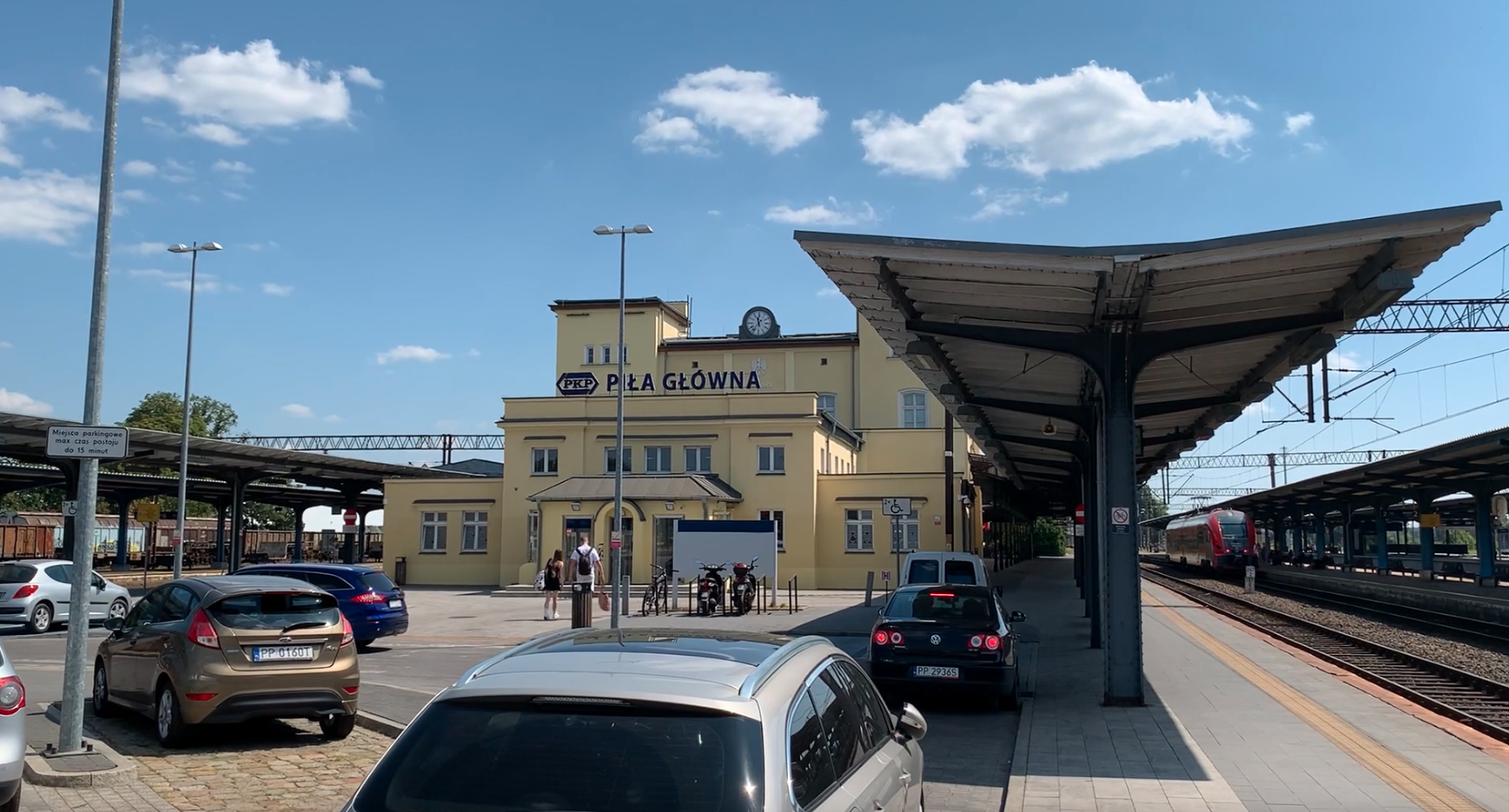
Leave a Reply
You must be logged in to post a comment.